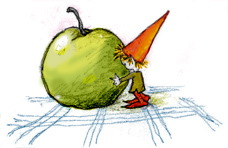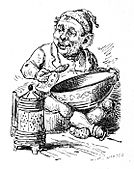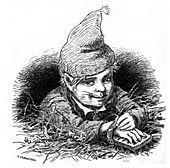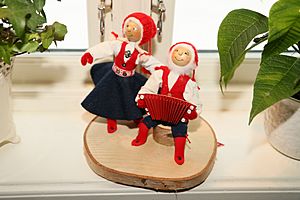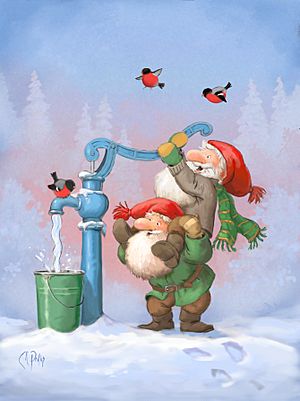Nisse (folklore) facts for kids
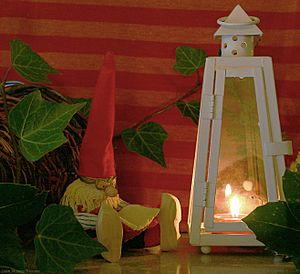
A nisse (in Danish and Norwegian) or tomte (in Swedish) is a magical creature from Nordic folklore. People often think of them around the winter solstice and Christmas time. They are usually described as short, with a long white beard. They wear a pointy or knit cap, often in red or gray. They might remind you a bit of a garden gnome.
The nisse is one of the most famous creatures in Scandinavian stories. You can find them in many books and tales. During the 1800s, people started collecting old folk stories. This made the nisse even more popular.
Contents
Understanding the Nisse and Tomte
―Illustration by Vincent Stoltenberg Lerche.
―Illustration by Hans Gude. Asbjørnsen (1896) Norske Folke- og Huldre-Eventyr
The word nisse is used in all Scandinavian countries. In Norway, people also sometimes say tufte for a similar creature. The word tomte is mostly used in Sweden.
What Nisse Means in English
When Danish stories are translated into English, nisse is sometimes called a 'goblin'. For example, in Hans Christian Andersen's tale "The Goblin at the Grocer's". Some translations also use the word "brownie" to describe them.
Where the Names Come From
The name nisse might come from an old word meaning "dear little relative." Another idea is that it comes from "Nils," which is a Scandinavian version of "Nicholas."
The word tomte means "homestead man." This name shows that they are connected to farms and homes. In Finland, they are called tonttu, which also relates to a house or yard.
Nisse in History and Culture
Traditionally, the nisse lives in farmhouses and barns. They secretly act as guardians of the home. If you treat them well, they protect the family and animals from bad luck. They might even help with chores around the farm.
However, nisse can get angry easily. This happens especially if they feel disrespected or if farmers are lazy. If a nisse is insulted, they might play tricks. They could steal things or even harm animals.
How a Nisse Looks
A nisse or tomte is often seen as a small, old man. Their size can vary, from a few inches to about half the height of an adult. They usually have a full beard. They wear old-fashioned farmer clothes, like a wool tunic and knee-length pants with stockings. This style of clothing was common in Scandinavia in the 1600s.
Some stories say they can change their shape. They might even become much larger than a human. Other tales describe them with only one eye, like a Cyclops. In modern Denmark, nisser are often shown without beards. They wear gray and red wool clothes with a red cap.
Nisser are thought to be good at hiding. They can even make themselves invisible. So, people usually only get quick glimpses of them. Norwegian stories say they have four fingers. Sometimes their ears are pointed, and their eyes reflect light in the dark, like a cat's.
How Tall Are They?
Some stories say a tomte is about 60 to 90 centimeters (2 to 3 feet) tall. Other old Swedish traditions say they are about 60 centimeters (2 feet) tall.
Nisse Personality
Even though they are small, nisse are very strong. They get upset easily if people are careless or don't show enough respect. They also dislike lazy farmers. As protectors of the farm and animals, they punish bad behavior. This can range from small pranks, like a hard tap on the ear, to more serious things. They might even harm animals or ruin the farm's luck.
Nisse like things to stay the same. They don't like changes in how things are done on their farms. They also get offended by rudeness. If you spill something on the floor in a nisse's house, it's polite to shout a warning to them.
You are also expected to give gifts to the nisse. A common gift is a bowl of porridge on Christmas Eve. If the tomte doesn't get his gift, he might leave the farm. Or he might cause trouble, like tying cows' tails together or breaking things. The nisse especially likes his porridge with a pat of butter on top.
The nisse cares for all farm animals, but horses are their favorite. People believed you could tell which horse was the tomte's favorite because it would be extra healthy. Sometimes the tomte would even braid the horse's hair and tail. Untying these braids without permission could bring bad luck or make the tomte angry.
An angry tomte appears in a famous children's book. It's called Nils Holgersson's Wonderful Journey Through Sweden by Selma Lagerlöf. In the story, the tomte turns a naughty boy named Nils into a tomte. Nils then travels across Sweden on the back of a goose.
Nisse After Christianity Arrived
In ancient times, people believed the nisse was the "soul" of the first person to live on the farm. This person was thought to have cleared the land for the house. The nisse was believed to live in the burial mounds on the farm. This is why some old names for them mean "mound man" or "house lot man."
The nisse was not always popular, especially after Christianity came to Scandinavia. Like many old folk creatures, the nisse was sometimes seen as pagan (not Christian). People might connect them to bad spirits. Farmers who believed in the house tomte were sometimes thought to be worshipping false gods. In the 1300s, Saint Birgitta warned against worshipping "tomte gods."
Folklore added other negative ideas about the tomte. Some believed having a tomte on your farm put your soul at risk. Others thought you had to do non-Christian rituals to attract a tomte.
The idea that a nisse could bring wealth to a farm also caused problems between neighbors. If one farmer was doing much better than others, people might say it was because he had a nisse. They might accuse the nisse of doing "unholy" work and stealing from neighbors. These rumors could really harm the accused farmer.
Similar Creatures in Folklore
The nisse is similar to other Scandinavian spirits called vättar (in Swedish) or vetter (in Norwegian). However, these beings are usually social, while the nisse is often alone. Other names for the nisse include "farmyard-dweller" or "yard-warden." In Norway, they are sometimes called "barn gnome."
The tomte could also live on a ship. Then they were known as a "ship tomte." In Finland, there is a saunatonttu, who lives in the sauna.
Many other European folk creatures are similar to the nisse. These include the English brownie, the German Heinzelmännchen, and the Slavic domovoi.
Modern Nisse and Christmas
Today, the nisse or tomte is strongly linked to Christmas. In Sweden, he is called Jultomten, and in Norway, Julenissen. He is sometimes joined by another mythical creature, the Yule goat. On Christmas Eve, they might knock on doors and hand out presents.
The nisse delivers gifts at the door, much like the modern Santa Claus. The tomte/nisse is also often seen with a pig. The pig is another popular Christmas symbol in Scandinavia. It probably relates to good luck and the nisse's role as a farm guardian. It is still a tradition to leave a bowl of porridge with butter for the tomte/nisse. This is a way to thank them for their help.
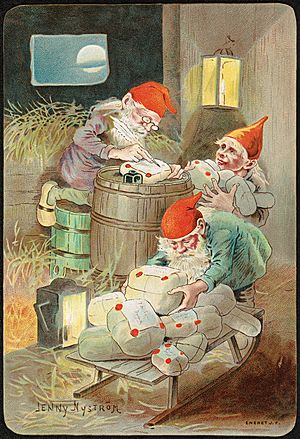
In the 1840s, the farm nisse started bringing Christmas presents in Denmark. He was then called julenisse (Yule Nisse). In 1881, a Swedish magazine published a poem called "Tomten." It featured the first painting by Jenny Nyström of this traditional Swedish character. She made him into the friendly, white-bearded, red-capped figure we know today. Soon after, the nisse/tomte began bringing Christmas presents in Sweden and Norway. This replaced the old tradition of the Yule goat bringing gifts.
Over time, the nisse has started to look more like the American Santa Claus. But the Swedish jultomte, Norwegian julenisse, Danish julemand, and Finnish joulupukki still have their own local traditions. He doesn't live at the North Pole. Instead, he might live in a nearby forest. In Denmark, he lives in Greenland, and in Finland, in Finnish Lapland. He doesn't come down the chimney. He comes through the front door and gives presents directly to children, just like the Yule Goat used to. He is not usually overweight. Even if he sometimes rides in a sleigh pulled by reindeer, his reindeer don't fly. In Sweden, Denmark, and Norway, some people still put out a bowl of porridge for him on Christmas Eve.
He is often shown on Christmas cards and decorations. He looks like the little man from Jenny Nyström's drawings. He is often with a horse or cat, or riding a goat. For many people, the idea of the farm tomte still lives on in stories and imagination.
The word tomte in Swedish can mean different things now. If people say jultomten (the Christmas tomte), they usually mean the modern version. But if they say tomtar (plural), they might be talking about the more traditional farm tomte. The old meaning of tomte also lives on in a saying. It refers to a person who takes care of a property. It can also mean someone who mysteriously does a favor for you, like hanging up your laundry.
Nisser/tomte often appear in Christmas calendar TV shows and other modern stories. In some versions, they are very small. In others, they are human-sized. Nisse usually stay hidden from humans and can often use magic.
Garden Gnomes
The traditional look of a nisse or tomte is very similar to a garden gnome figurine. In Swedish, garden gnomes are called trädgårdstomte. In Danish, they are havenisse, and in Norwegian, hagenisse.
See also
- Brownie (Scotland and England)
- Domovoi (Slavic)
- Dwarf
- Elf
- Christmas elf
- Gnome
- Heinzelmännchen (Germany)
- Kabouter (The Netherlands)
- Hob (Northern England)
- Household deity
- Kobold (Germany)
- Legendary creature
- Leprechaun (Ireland)
- Santa Claus
- Sprite
- Tonttu (Finland)
- Yule Lads (Iceland)


